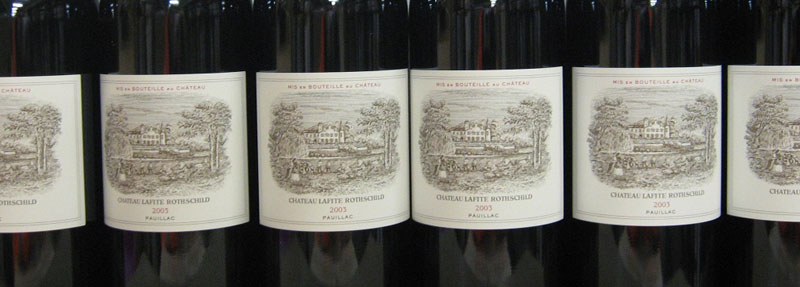At last, we welcome the return of some positive press (FT, Forbes), regarding the short to medium term prospects for wine investment performance providing some much needed respite from the stories surrounding a couple of fraudulent operators.
Nonetheless, reports in the mainstream consumer press serve to raise awareness of the perils of using the wrong agent when dealing with wine or indeed any asset class for that matter.
While it is true that the mantra of caveat emptor or ‘buyer beware’ should be ringing loudly in the ears of any would-be investors, the impressive track record of growth seen in the wine market over the last 20 years is very hard to ignore.
Exceptional wines like the Lafite Rothschild 2003 are currently offering fantastic growth potential.
With such an uncertain economic outlook, particularly in Europe, it would be somewhat ingenuous to overlook the benefits of fine wine as a tangible asset class. It is easily stored and insured, each vintage is finite and diminishing in supply and global demand continues to grow.
On this point, it is worth noting that with the recent stimulus packages implemented in China and the US, (and the relaxing of financial regulations in China), the IMF have predicted GDP growth in China at 8.2% in 2013, up from 7.8% this year. With the inevitable inflation that will follow the sheer scale of cash injections we are seeing into these economic giants, wine can also be considered a good store of wealth as currencies suffer.
Following a four year hiatus, the US market, once the biggest buyer of classified Bordeaux before China’s involvement, is once again becoming more active. This leaves the market in far better shape for the long term than it has been at any point since the two year bull-run that followed June 2008. Greater diversity in global demand combined with the price corrections seen throughout 2011 highlight the excellent value on offer for those wanting to begin or add to a wine portfolio.
As always, one should be diligent when researching a potential investment or investment provider – make a check list:
– Research thoroughly and know the fundamentals of what drives the market, (in this case, finite and diminishing supply against growing global demand).
– Although there are tax benefits in the UK for those holding physical stock in their name it is always advisable to consult with a tax professional regarding matters of taxation.
– Check with Companies House that the company is incorporated, that all tax returns are up to date and that they are not simply registered to a swanky serviced office address intended to impress potential investors.
– Does the company have a track record of performance and what are they using as a benchmark to substantiate their claim? (discussed below).
– Confirm with the bonded storage facility that the company who claims to store wines there actually does.
– Check that the price you are being offered is a fair market price, (more on this below).
This type of methodical approach to the market needn’t be time consuming but is an important way to be sure that the company whose advice you are considering taking is legitimate. There is no reason why you should take a company’s word as read, particularly one that is trying to sell to you, so knowing how and where to establish that information is credible and independently verifiable is the surest way to put your best foot forward.
The introduction of Liv-ex or the London International Vintners Exchange around 12 years ago played a significant part in the evolution of wine investment by providing a trusted means of benchmarking market performance. As an execution only trading platform, Liv-ex is used by 85% of the international wine trade and can be compared with the London Stock Exchange only for the professional wine trade.
Since its introduction, Liv-ex has provided the sort of transparency to the wine market that simply wasn’t available before its inception and has been instrumental in the wine market being viewed as a credible investment class by the investor at large.
Using current and historical prices that merchants are paying or have paid, the price performance of any one wine can be accurately traced from its en primeur (in the barrel) release and in turn used as a benchmark. A company claiming a history of trading and performance should ideally be a trading member of Liv-ex and using one of the recognised indices from Liv-ex as comparison.
Another valuable tool is the price check comparison site Wine Searcher that allows buyers to see the price a wine is actually selling at through recognised merchants and brokers. Do check that you are looking at the correct size format of bottle and be aware that for investment purposes, wines trade most frequently by the original wooden case, (x 6 or x12 bottles), in 75cl format. Some of the better brokers and portfolio managers may have a price comparison tool on their website where you can check the market average price to make sure you are getting a fair deal.
Written by Mark Douglas
Mark Douglas is a founding director of Fine Wine brokers, Wilson Douglas. Since the beginning of 2009 the wines recommended by Wilson Douglas have shown an average growth of 52%. If you are considering the market for fine wine and would like to learn more, Wilson Douglas would be happy to provide you with some valuable advice on getting a fair deal.
www.wilsondouglas.co.uk T: 020 8567 3654








